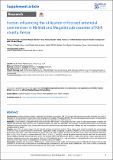| dc.contributor.author | Chorongo, Dorah | |
| dc.contributor.author | Okinda, ,Fredrick Majiwa | |
| dc.contributor.author | Kariuki, Eric Jimmy | |
| dc.contributor.author | Mulewa, Emily | |
| dc.contributor.author | Ibinda, Fredrick | |
| dc.contributor.author | Muhula, Samuel | |
| dc.contributor.author | Kimathi, George | |
| dc.contributor.author | Muga, Richard | |
| dc.date.accessioned | 2021-08-24T20:54:01Z | |
| dc.date.available | 2021-08-24T20:54:01Z | |
| dc.date.issued | 11/26/2016 | |
| dc.identifier.citation | The Pan African Medical Journal. 2016;25 (Supp 2):14 | en_US |
| dc.identifier.issn | 1937-8688 | |
| dc.identifier.uri | http://repository.amref.org/handle/123456789/136 | |
| dc.description | © Dorah Chorongo et al. The Pan African Medical Journal - ISSN 1937-8688. This is an Open Access article distributed under the terms of the Creative Commons Attribution License (http://creativecommons.org/licenses/by/2.0), which permits unrestricted use, distribution, and reproduction in any medium, provided the original work
is properly cited. | en_US |
| dc.description.abstract | Introduction: globally, pregnancy related complications contribute to more than half of the deaths among women annually. Antenatal care (ANC) is
important for the prevention of maternal and fetal mortality and morbidity. This study identifies the socio-demographic and economic characteristics;
knowledge and attitude and; health service provision for focused antenatal care (FANC) services.
Methods: a cross-sectional comparative study conducted among 385 women of reproductive age who visited 5 public health facilities in Malindi and
Magarini Sub Counties. Data collection was conducted between June 2013 and September 2013 through structured questionnaires, Key Informant
Interviews (KIIs) and Focused Group Discussions (FGDs) and analyzed through descriptive summary statistics and test of associations of the various
variables using chi square.
Results: about 35% of women sought 1st and 2nd ANC services at the health facilities. These women went ahead to complete the recommended
4 minimum visits as recommended by World Health Organization (WHO). Compared to Catholics, Muslims were less likely to attend a rural health
facility (Odds ratio (OR) = 0.25, 95% Confidence Interval (CI) 0.10, 0.62, p=0.003). According to education levels, those with secondary (OR=0.07,
95% CI 0.03, 0.18, p<0.001) or tertiary (OR=0.09, 95% CI 0.03-0.17, p<0.001) levels of education were less likely to seek FANC at rural facility.
Women seeking rural ANC services started at 2nd or 3rd trimester (OR=5.40 95% CI 2.97-10.06, p<0.001) while those in urban setup start at 1st
trimester. Among the women who were aware of FANC, only 27% utilized its services. Long waiting hours, unavailability of services, and departmental
disharmony were major causes of dissatisfaction to mothers visiting the facilities.
Conclusion: utilization and awareness of FANC services in both rural and urban health facilities among women in Malindi and Magarini Sub Counties
continues to be low which is associated by socio-demographic characteristics, and health facility inefficiencies. Thus there is need to standardize
services across health facilities and increase awareness on FANC in both rural and urban. | en_US |
| dc.description.sponsorship | African Medical Research Foundation | en_US |
| dc.language.iso | en | en_US |
| dc.publisher | Pan African Medical Journal | en_US |
| dc.relation.ispartofseries | Strengthening health systems in communities: the experiences of AMREF Health Africa;Supp. 2: 14 | |
| dc.subject | Antenatal care | en_US |
| dc.subject | Attendance | en_US |
| dc.subject | Health service delivery | en_US |
| dc.title | Factors Influencing the Utilization of Focused Antenatal Care Services in Malindi and Magarini Sub-counties of Kilifi County, Kenya | en_US |
| dc.type | Article, Journal | en_US |

